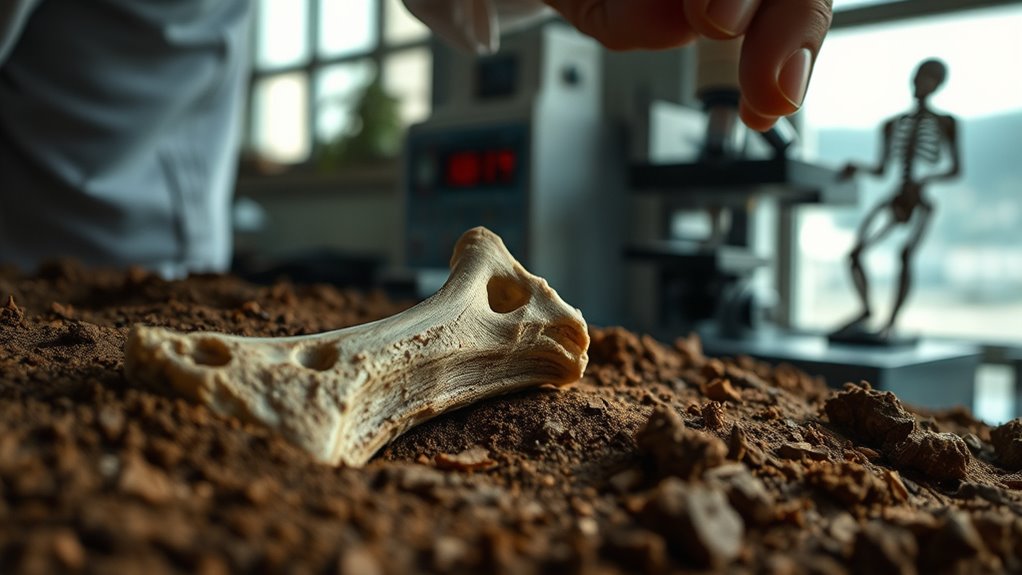Ancient DNA analysis reveals fascinating secrets about extinct hominins like Neanderthals and Denisovans. You’ll discover how these early humans adapted to harsh environments and contributed genetically to modern humans, particularly in Europe. Their unique traits, such as lighter skin for vitamin D synthesis and altitude adaptations, still influence our health today. This research enhances our understanding of human evolution and interconnections. There’s so much more to uncover about our distant relatives and their lasting impact on us.
Key Takeaways
- Ancient DNA analysis uncovers genetic adaptations that enabled extinct hominins like Neanderthals and Denisovans to survive in harsh environments.
- Neanderthals possessed genes for lighter skin and hair, aiding vitamin D synthesis in low-light conditions.
- A small percentage of Neanderthal DNA persists in modern Europeans, highlighting interbreeding between species.
- Denisovans are genetically distinct and adapted to high-altitude environments, showcasing their specialization.
- Ancient genetics influence modern human traits, reflecting survival strategies and interconnectedness of ancient and contemporary populations.

As scientists discover the secrets held within ancient DNA, you might be surprised to learn how much it reveals about our extinct relatives. Through the analysis of genetic material from Neanderthals and Denisovans, you’re not just peering into the past; you’re also uncovering the adaptations that allowed these hominins to survive in harsh environments.
Neanderthal adaptation is a fascinating area of study. These ancient humans thrived in Europe and parts of Asia, coping with icy climates and limited resources. Their DNA shows unique adaptations that helped them endure the cold. For instance, scientists have identified specific genes linked to their skin and hair color, suggesting that Neanderthals possessed lighter skin, which would’ve been advantageous in low-light conditions. Such traits likely helped them synthesize vitamin D more efficiently in northern latitudes, showcasing how closely linked genetics is to survival. You might find it intriguing that the genetic adaptations of Neanderthals also influenced modern humans. If you have European ancestry, you likely carry a small percentage of Neanderthal DNA, a testament to the interbreeding that occurred between our species.
On the other hand, Denisovan genetics present another layer of complexity. Discovered relatively recently, Denisovans are less understood but equally significant. Their DNA, extracted from a single finger bone found in Siberia, reveals that they were genetically distinct from both Neanderthals and modern humans. Analysis shows that they adapted to high-altitude environments, which is particularly fascinating. The presence of specific genes associated with altitude adaptation indicates that they were uniquely equipped to thrive in mountainous regions. If you’ve ever felt uneasy at high altitudes, you can thank the Denisovans for their genetic legacy, as some of their adaptations have been passed down through interbreeding with early modern humans. Furthermore, studies have highlighted how these adaptations reflect survival strategies in extreme climates, further linking ancient genetics to contemporary human health.
Frequently Asked Questions
How Is Ancient DNA Extracted From Archaeological Sites?
To extract ancient DNA from archaeological sites, you start by carefully collecting samples, ensuring you avoid contamination. You’ll face preservation challenges, as DNA degrades over time. It’s essential to work in sterile conditions and use specialized tools to prevent modern genetic material from mixing with ancient samples. Once you’ve isolated the DNA, you can analyze it using techniques like PCR to uncover valuable genetic information about past organisms.
What Techniques Are Used to Analyze Ancient DNA?
To analyze ancient DNA, you’ll typically use DNA sequencing techniques like next-generation sequencing, which allows for the rapid analysis of genetic material. It’s essential to implement contamination prevention strategies, such as working in clean environments and using protective gear, to guarantee the accuracy of your results. By carefully extracting and sequencing the DNA, you can uncover valuable information about past species and their evolutionary history.
Are There Ethical Concerns Regarding Ancient DNA Research?
Yes, there’re significant ethical concerns regarding ancient DNA research. You’ve got to consider genetic privacy—who owns this information? You’ve got to think about cultural sensitivity—how will this affect descendant communities? Both issues intertwine, raising questions about consent and representation. When you delve into this research, it’s crucial to respect the wishes and rights of living descendants while balancing scientific curiosity with ethical responsibility. Your choices can shape the future of this field.
How Does Ancient DNA Impact Our Understanding of Modern Humans?
Ancient DNA substantially enhances your understanding of modern humans by revealing our genetic diversity and migration patterns. It uncovers how early human populations interacted and adapted to their environments. By tracing lineage and identifying markers, you see how migrations shaped genetic variation today. This knowledge helps you grasp the complex web of human ancestry, showing that your background is intertwined with those who walked the Earth long before you.
What Are the Limitations of Studying Ancient DNA?
Studying ancient DNA feels like piecing together a puzzle with missing parts. You face contamination risks, which can muddle results and lead to inaccurate conclusions. Preservation challenges also play a significant role; DNA degrades over time, making it tough to obtain usable samples. Additionally, the limited quantity of ancient DNA can restrict your understanding, as you might not capture the full picture of our ancestors’ genetic makeup and their evolutionary journey.
Conclusion
In unraveling the threads of ancient DNA, you’ve unearthed the whispers of lost hominins, echoing through time like distant stars in a darkened sky. Each fragment of genetic material is a key, revealing tales of survival, adaptation, and the intricate dance of evolution. As you piece together these stories, you realize that humanity’s journey is woven from the fabric of countless lives, reminding you that the past is never truly gone; it lives on within us all.










